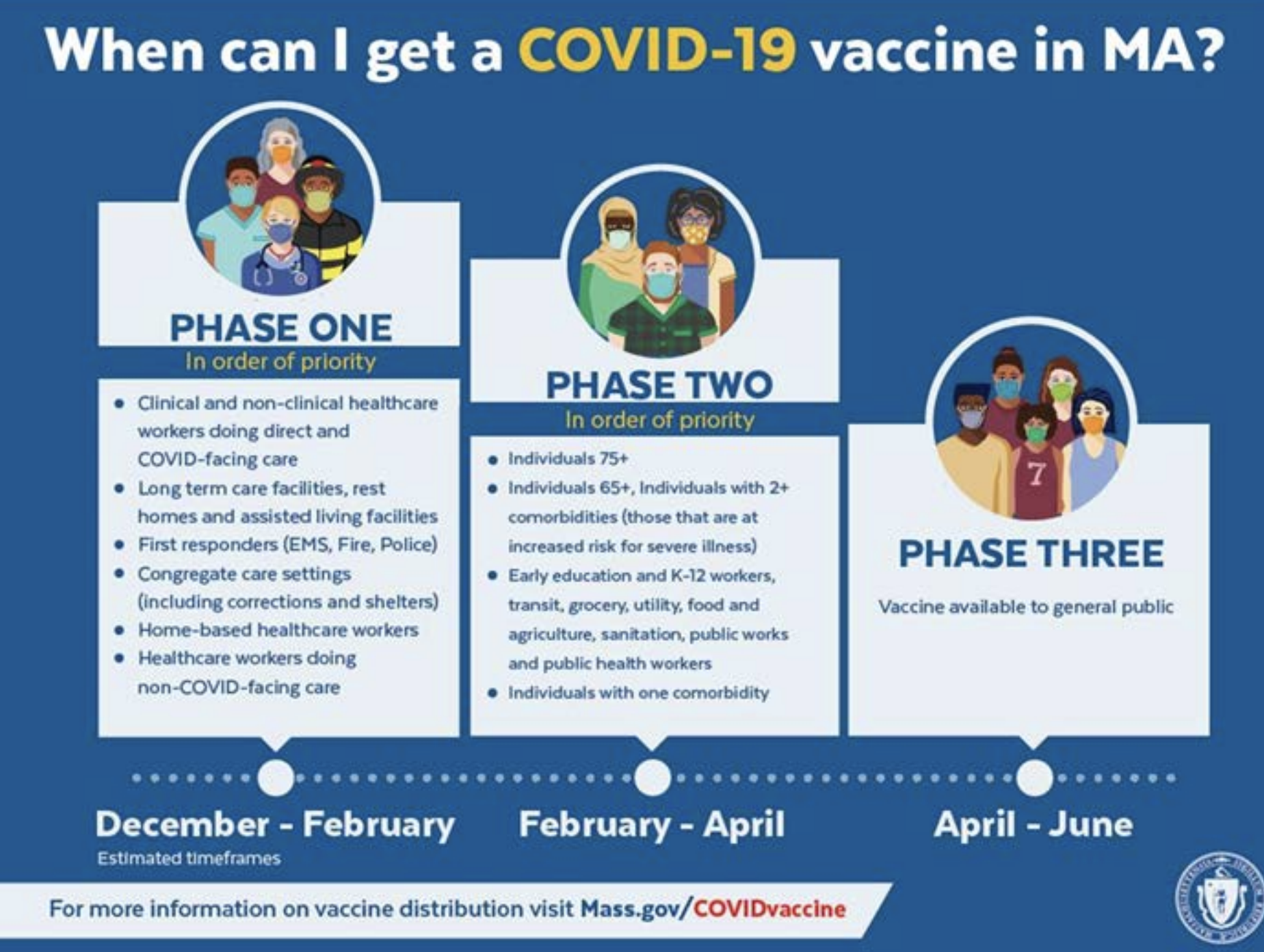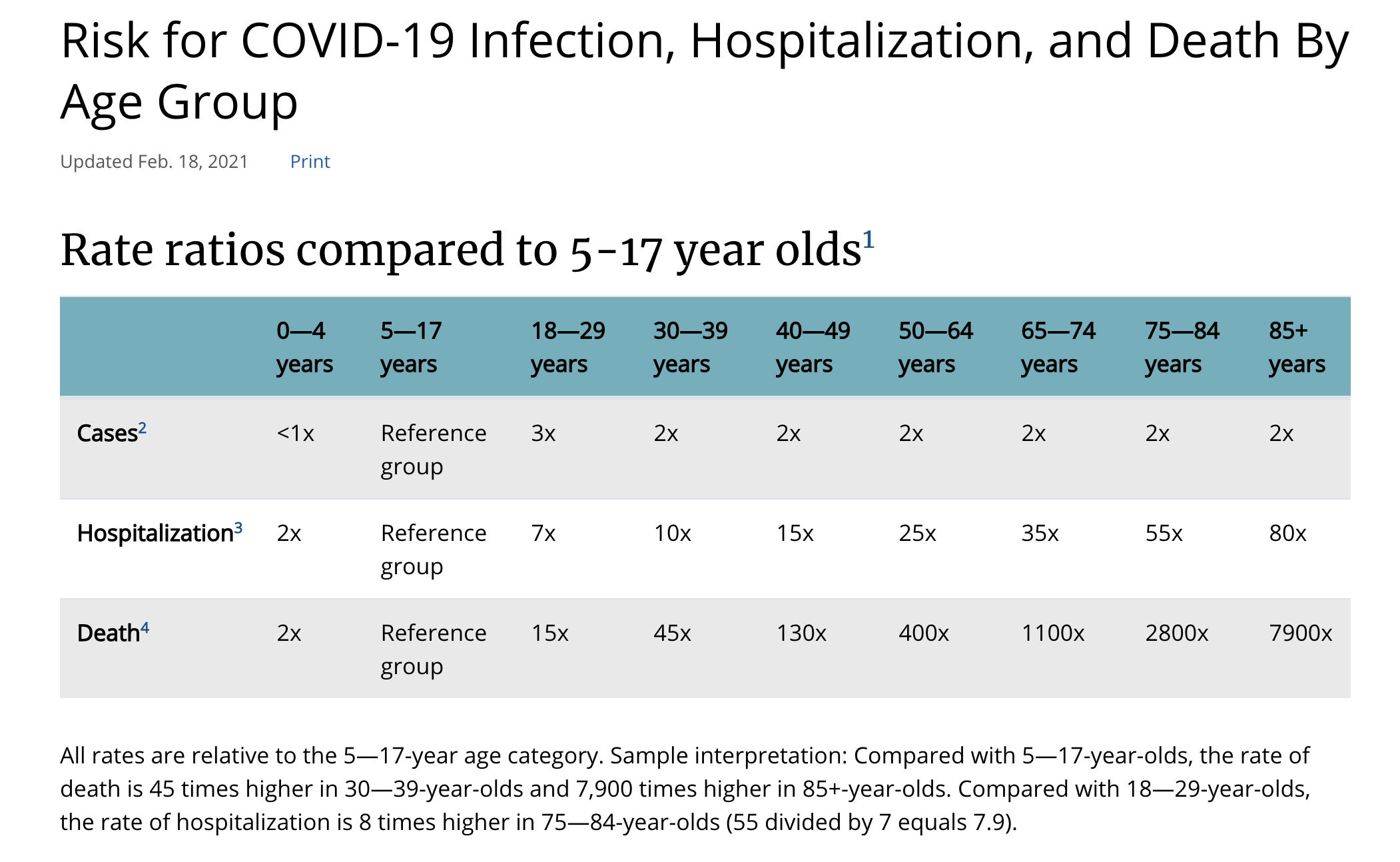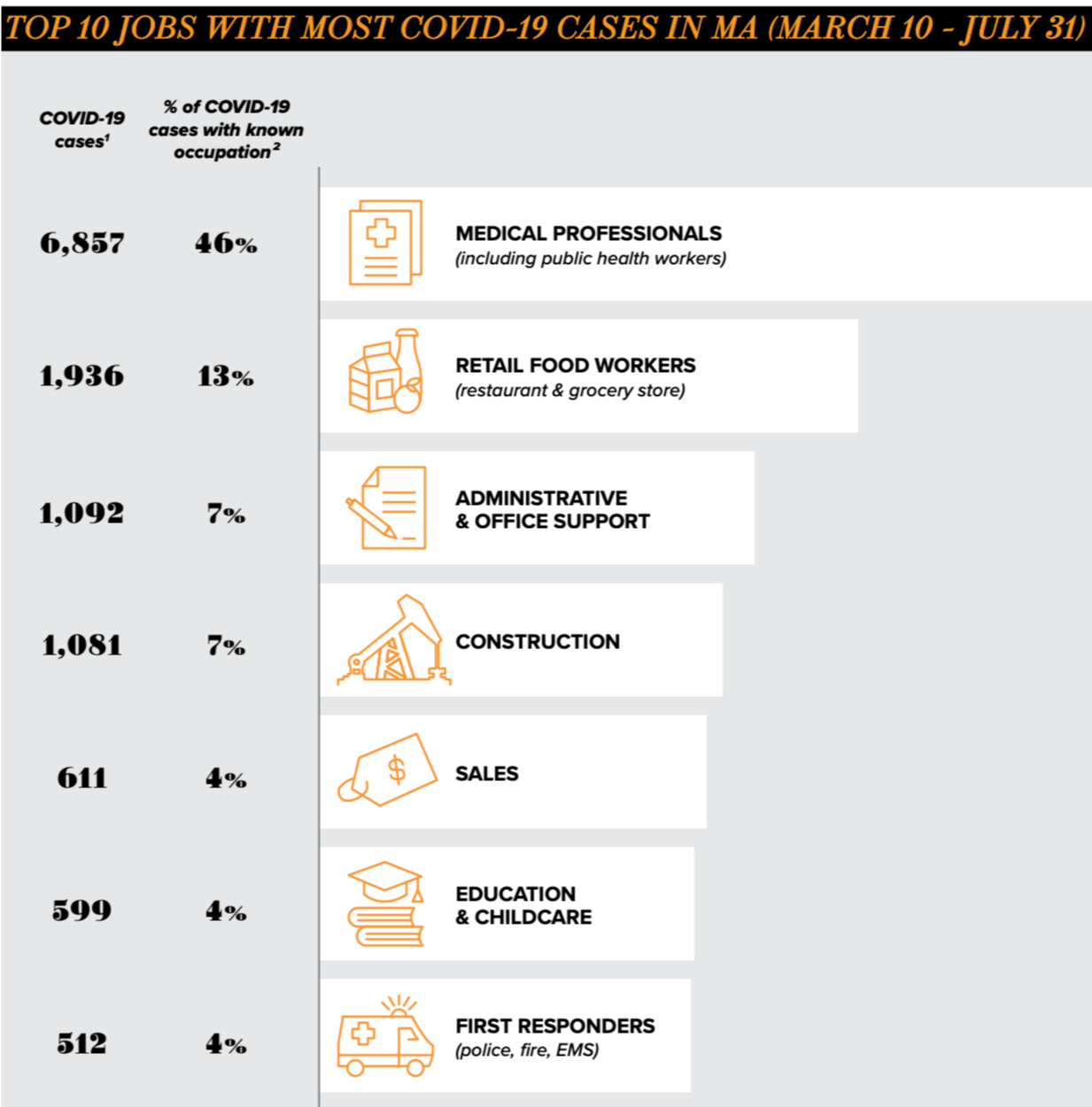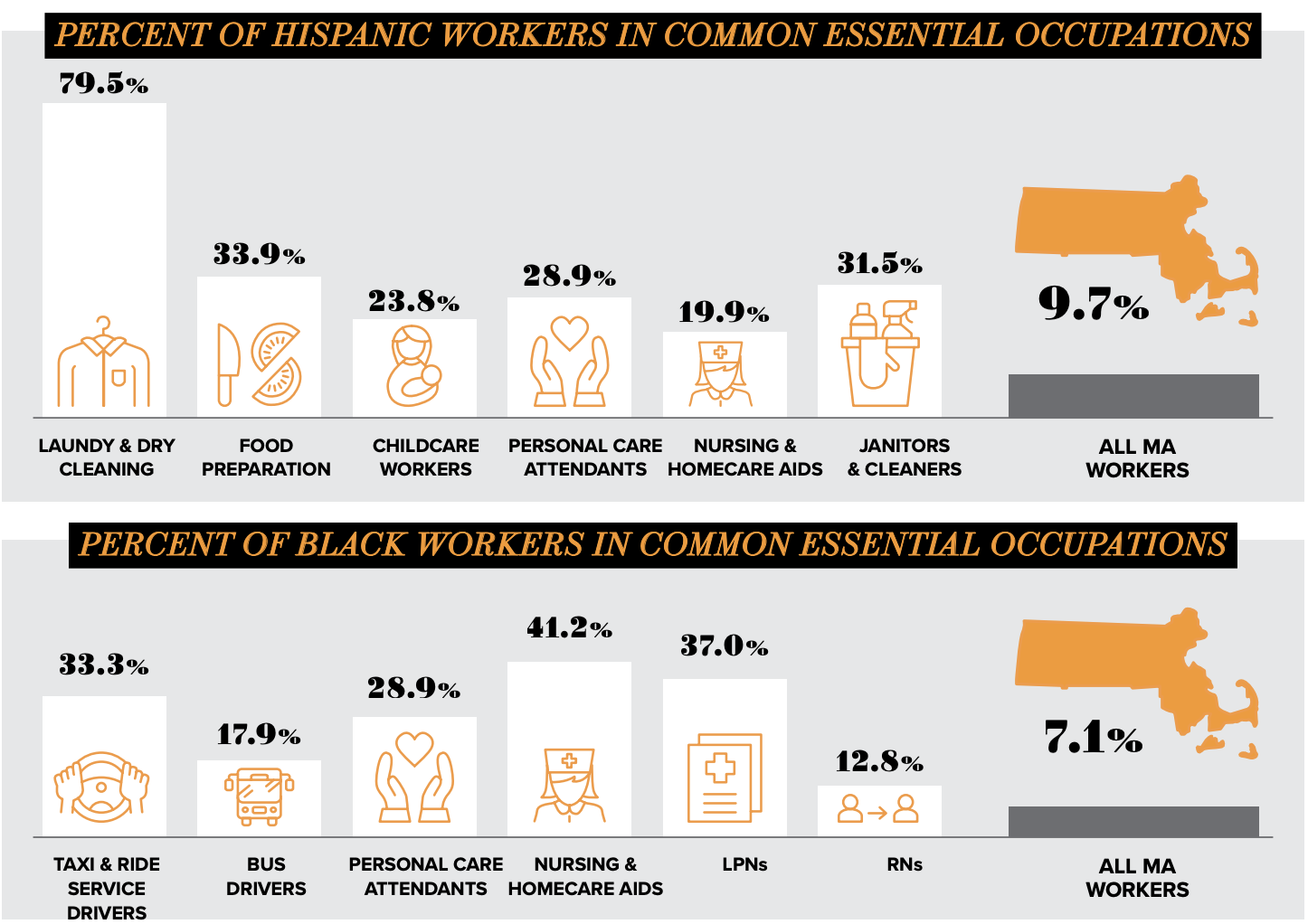POP QUIZ:
Massachusetts has about 4.9 million people over 18 years old.
We intend to vaccinate 4.1 million, or 85%, to get to herd immunity.
If we continue to receive a little over 100,000 doses a week and each person gets 2 doses,
approximately how long will it take to reach our goal?
(answer sheet at end)
|
|
|
Dear Neighbor,
Tomorrow, Thursday, February 25 at 11 am the Joint Committee on
COVID-19 and Emergency Preparedness and Management will hold a hearing
on vaccine distribution. The hearing will begin at 11 AM and be
livestreamed on MALegislature.gov. Gov. Charlie Baker will testify first.
This newsletter is about how the Baker administration decided on priorities
in distributing the COVID vaccine. It is the fourth in a series on the
rollout of vaccination in Massachusetts. Here are previous
newsletters:
Vaccination Frustration
Vaccination Tips
The Contagion Next Time
As of Feb. 23, 1,476,276 doses have been administered in Mass. out of
1,729,550 received from the federal government. You can get daily
updates here. 414,941 have been fully vaccinated; 1,061,335 have received at least one dose.
Here is the current order in which people will receive COVID vaccines:

|
|
WHY ARE GROUPS IN THOSE PHASES?
 The
administration says they use the criteria at the left. The circles are
the same size, but it matters which criteria are prioritized. The
administration says they use the criteria at the left. The circles are
the same size, but it matters which criteria are prioritized.
The CDC's criteria are similar but not the same:
- Decrease death and serious disease as much as possible.
-Preserve functioning of society.
- Reduce the extra burden COVID-19 is having on people already facing disparities.
Applying these criteria is not easy: Dr. Galea, whose presentation I
shared last week, writes, " he balance between public health and
politics has been, thus far in the Covid moment, so skewed towards
politics as to make public health considerations a distant second."
PHASE ONE groups started being phased in December 14. The state mostly followed CDC recommendations.
Most people agreed with the need to vaccinate healthcare workers doing COVID facing care.
I was particularly pleased that Massachusetts included hospital workers
doing food service and "environmental services" such as cleaning. The Globe reported
that hospital janitorial workers were four times more likely than
nurses to be infected; hospital food service workers and respiratory
therapists were twice as likely as nurses to get sick. Not all states
prioritized these non-professionals, so I was happy with this decision.
Everyone also agreed with the importance of vaccinating residents and workers in nursing homes. (For a previous newsletter about COVID in nursing homes, click here.)
I was very pleased that the administration included people in prison in
this early phase, despite criticism from somea. For a newsletter about
why correctional institutions are hotbeds for the virus, click here. According to the CDC, 3484
incarcerated people in Massachusetts have contracted COVID and 30 have
died; while there have been 757 cases among staff. (The count of deaths
may be a little low, as we have heard of at least four individuals
granted medical parole hours before their deaths.) Unfortunately, more
than half of correctional officers appear to be declining vaccination.
PHASE TWO began February 1, for people over 75 years old. Some of my thoughts on that rollout are in previous newsletters.
At the same time, the administration changed priorities. They
moved essential workers below 65-74 year olds and those with two or more
co-morbidities. Essential workers in this grouping
include early educators and K-12 teachers, grocery and sanitation
workers, and public health workers. This was very good news for older
adults; very bad news for the essential workers we thanked so effusively
last spring.
About a million people are over 65, and are now ahead of essential workers.
Was this move justified by science? The CDC recommendation is still to prioritize essential workers. Their evidence is here. But these decisions are far from clear-cut or easy.
I asked Sec. Marylou Sudders why the administration moved essential workers lower. In answer, she shared this graph:

So if you just look at age, you see that the risk of infection is about the same from age 30 to age 85+, but the risk of serious harm and death increases greatly with age. So it would make sense to make age the main criterion.
However, this chart, from the same CDC site, shows that Black and Latinx people are 3 times more likely to be hospitalized and twice as likely to die, despite apparently being
infected at the same rate. This suggests that they may be less likely
to be tested until they show symptoms. In any case, if we want to
reduce death and hospitalization, we should figure out the reasons for
these disparities.

 Age is not the only risk factor for infection. The chances of getting infected are not the same for everyone in an age group. Age is not the only risk factor for infection. The chances of getting infected are not the same for everyone in an age group.
People in nursing homes, who can't isolate themselves, are more at risk
of getting sick. People in occupations that require contact with the
public can't isolate either. This chart shows that 9% of people in the
lowest quartile of income are able to work remotely. 62% of those in
the top quartile of income can work remotely. Retired people also have a
better chance of being able to isolate themselves. This is why people in many essential jobs are much more likely to get sick.
 MassCOSH's Report, Dying for Work, analyzes the very limited information on the occupations where the most people have been infected, as shown on the left. MassCOSH's Report, Dying for Work, analyzes the very limited information on the occupations where the most people have been infected, as shown on the left.
The report also shows that Black and Latinx people are more likely to work in those essential jobs

This suggests why Black and Latinx people are more likely to die of
COVID, regardless of age. In fact, they are less likely to live to be
age 75+.
Educators are another group of essential workers. It
seems to me that if state policy requires a group, such as teachers, to
work in close contact with the public they should be given priority over
those of us who are older but can stay safely at home. (More about
schools soon.)
Then there are all the diseases and conditions that could be considered as co-morbidities,
allowing people to move into the current phase. These are very
difficult and complex decisions, with no clear evidence to determine who
should go first.
In another controversial decision, on February 8, the administration announced the "buddy system:" younger people who accompany 75+ year olds for a vaccination - only at a mass vaccination site
- can also receive the vaccine. We started seeing Craigslist ads,
promising hundreds of dollars to older folks who would let someone drive
them to an appointment so the buddy would get a shot. I have not found
any organization representing or serving older adults that was
consulted in making this decision.
In a recent press conference,
Council on Aging directors in Merrimack Valley unanimously said their
members would much prefer to go to a local site, rather than riding with
a stranger to the mass vaccination sites such as Gillette. They said
they could easily provide transportation to local vaccinations, but
would have a hard time providing drivers to drive individuals a long way
to regional mass sites.
 Click here to enjoy Trevor Noah's take on the Mass. "buddy system:" Click here to enjoy Trevor Noah's take on the Mass. "buddy system:"
Stay safe, and stay in touch,

|
|
POP QUIZ ANSWER
A little over a year and a half.
(credit for anything similar, with other units, for example 5840 days) | | | | |

0 comments:
Post a Comment